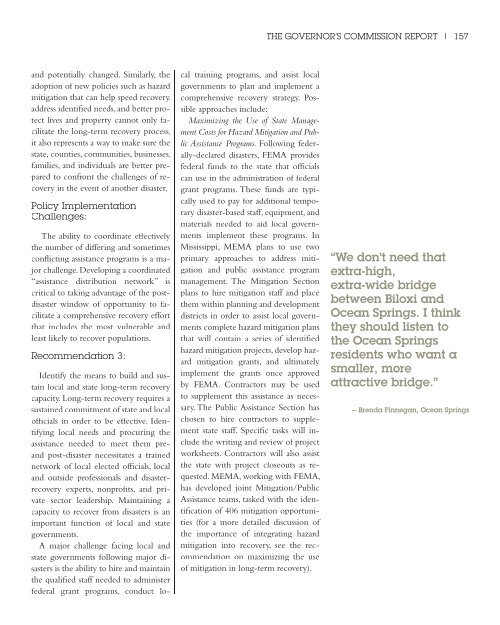Reports - Mississippi Renewal
Reports - Mississippi Renewal
Reports - Mississippi Renewal
- No tags were found...
Create successful ePaper yourself
Turn your PDF publications into a flip-book with our unique Google optimized e-Paper software.
THE GOVERNOR’S COMMISSION REPORT | 157and potentially changed. Similarly, theadoption of new policies such as hazardmitigation that can help speed recovery,address identified needs, and better protectlives and property cannot only facilitatethe long-term recovery process,it also represents a way to make sure thestate, counties, communities, businesses,families, and individuals are better preparedto confront the challenges of recoveryin the event of another disaster.Policy ImplementationChallenges:The ability to coordinate effectivelythe number of differing and sometimesconflicting assistance programs is a majorchallenge. Developing a coordinated“assistance distribution network” iscritical to taking advantage of the postdisasterwindow of opportunity to facilitatea comprehensive recovery effortthat includes the most vulnerable andleast likely to recover populations.Recommendation 3:Identify the means to build and sustainlocal and state long-term recoverycapacity. Long-term recovery requires asustained commitment of state and localofficials in order to be effective. Identifyinglocal needs and procuring theassistance needed to meet them preandpost-disaster necessitates a trainednetwork of local elected officials, localand outside professionals and disasterrecoveryexperts, nonprofits, and privatesector leadership. Maintaining acapacity to recover from disasters is animportant function of local and stategovernments.A major challenge facing local andstate governments following major disastersis the ability to hire and maintainthe qualified staff needed to administerfederal grant programs, conduct localtraining programs, and assist localgovernments to plan and implement acomprehensive recovery strategy. Possibleapproaches include:Maximizing the Use of State ManagementCosts for Hazard Mitigation and PublicAssistance Programs. Following federally-declareddisasters, FEMA providesfederal funds to the state that officialscan use in the administration of federalgrant programs. These funds are typicallyused to pay for additional temporarydisaster-based staff, equipment, andmaterials needed to aid local governmentsimplement these programs. In<strong>Mississippi</strong>, MEMA plans to use twoprimary approaches to address mitigationand public assistance programmanagement. The Mitigation Sectionplans to hire mitigation staff and placethem within planning and developmentdistricts in order to assist local governmentscomplete hazard mitigation plansthat will contain a series of identifiedhazard mitigation projects, develop hazardmitigation grants, and ultimatelyimplement the grants once approvedby FEMA. Contractors may be usedto supplement this assistance as necessary.The Public Assistance Section haschosen to hire contractors to supplementstate staff. Specific tasks will includethe writing and review of projectworksheets. Contractors will also assistthe state with project closeouts as requested.MEMA, working with FEMA,has developed joint Mitigation/PublicAssistance teams, tasked with the identificationof 406 mitigation opportunities(for a more detailed discussion ofthe importance of integrating hazardmitigation into recovery, see the recommendationon maximizing the useof mitigation in long-term recovery).“We don’t need thatextra-high,extra-wide bridgebetween Biloxi andOcean Springs. I thinkthey should listen tothe Ocean Springsresidents who want asmaller, moreattractive bridge.”-- Brenda Finnegan, Ocean Springs




